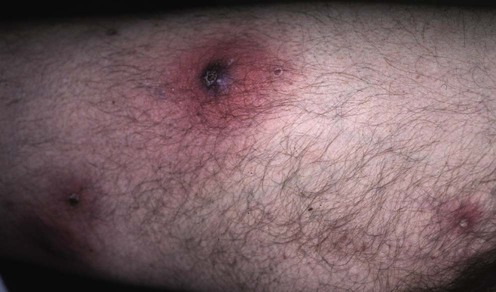Furunculosis

Management strategy
 Severe or extensive disease (e.g., involving multiple sites of infection)
Severe or extensive disease (e.g., involving multiple sites of infection)
 Rapid progression in presence of associated cellulitis
Rapid progression in presence of associated cellulitis
 Signs and symptoms of systemic illness
Signs and symptoms of systemic illness
 Associated comorbidities/immunosuppression (diabetes mellitus, HIV/AIDS, neoplasm)
Associated comorbidities/immunosuppression (diabetes mellitus, HIV/AIDS, neoplasm)
 Abscess in area difficult to drain completely (e.g., face, hand, and genitalia)
Abscess in area difficult to drain completely (e.g., face, hand, and genitalia)
Second-line therapies








 Surgery: incision and drainage
Surgery: incision and drainage Doxycycline or minocycline
Doxycycline or minocycline Trimethoprim/sulfamethoxazole
Trimethoprim/sulfamethoxazole Clindamycin
Clindamycin Linezolid
Linezolid Nasal mupirocin + chlorhexidine wash + oral antibiotics
Nasal mupirocin + chlorhexidine wash + oral antibiotics Nasal mupirocin
Nasal mupirocin Bleach bath
Bleach bath Colonization with less pathogenic staphylococci
Colonization with less pathogenic staphylococci Retapamulin
Retapamulin Fusidic acid
Fusidic acid